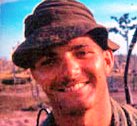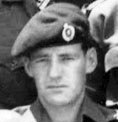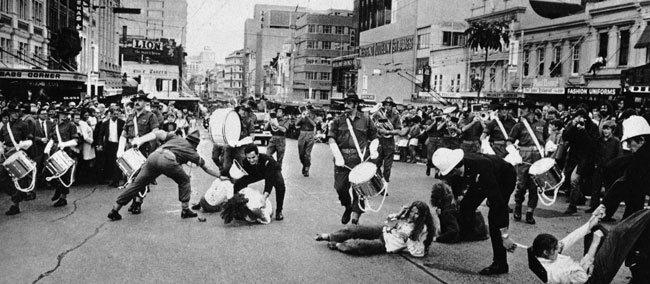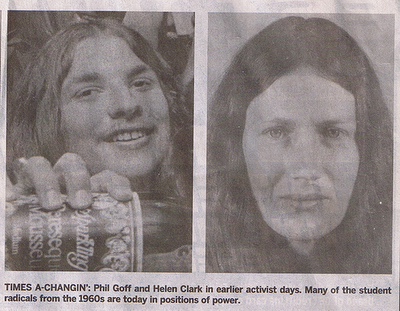Blunder that killed 60 troops -
Simon Kearney [reporter] Details of the ill-fated mission have been uncovered for the first time by military historian Greg Lockhart, whose painstaking study of official records, many of them only recently declassified, revealed what he describes as the greatest Australian military bungle since World War II. His research reveals that M16 mines planted on Brigadier Graham's orders were responsible for 12 per cent of Australian casualties in Vietnam from May 1967 to the withdrawal in 1971. Of the more than 50,000 Australians sent to Vietnam, 520 were killed. "The mines not only gave the enemy their No1 armament but when they laid them against us it helped the local VC leaders organise the population," Dr Lockhart told The Weekend Australian. Federal MP Graham Edwards, who lost his legs in 1970 when one of the M16 mines exploded, said Diggers nicknamed the minefield "Charley's ordinance depot" because of the number of mines that were stolen by the Viet Cong. "These were mistakes that cost a lot of lives and caused a lot of suffering," Mr Edwards said. Jumping jack mines were packed with gas that propelled them up to a metre above the ground before they exploded, causing serious injuries to its victims' legs and torso. They were usually fatal within a 25m radius. During the height of the operation, Brigadier Graham ordered that 1000 of the mines be laid each day, putting pressure on soldiers who had received scant operational training and were protected only with standard-issue flak jackets. Dr Lockhart, the Vietnam Veterans Association honorary historian, checked the records of every mine incident, interviewed scores of survivors and examined official taskforce records and battalion histories before concluding that at least 60 Australians had been killed and about 250 seriously wounded, including many who lost limbs. "We were just blown up by our own mines for no good reason, that's the chilling point," he said. More than 50 men were killed by stolen M16 mines during a later assault on the Minh Dam Viet Cong stronghold in the nearby Long Hai mountains and during patrols in Phuoc Tuy province between 1969 and 1971. In the worst incident, on February 28, 1970, two exploding M16 mines killed nine soldiers and wounded 15 8RAR soldiers on what came to be known as "Black Saturday" [see detail at end of link]. Brigadier Graham, who died in 1996, was warned by his engineer adviser and other advisers not to lay the minefield. His decision went unchecked by his superiors in Saigon and Canberra. In an interview with Dr Lockhart two years ago, the army chief in 1967 Lieutenant-General Sir Thomas Daly, who has since died, said he did not agree with the minefield. "I had discussed the minefield with Graham in Vietnam. I said I didn't think it was a good idea because protection would be a problem," he said. Even before the minefield was finished, local villagers were already lifting mines and giving them to the Viet Cong. By August and September 1967, hundreds were being lifted every night. As a result, the Viet Cong had gained a powerful weapon, one that effectively, according to Lockhart, allowed them to defend the key base area in the Long Hai mountains from Operation Pinaroo in 1968 and later operations in 1970. The psychological and physical scars of the use of mines - which Australia has since abandoned under the international Ottawa Agreement - are still fresh for many thousands of Diggers, most of whom served in Phuoc Tuy province. Private David McKenzie, who lost both legs and his right arm in Operation Pinaroo on March 22, 1968, is still angry about the mines. He said everyone knew they were Australian mines but no one said anything. "It was a different time," he said. "The commander, Brigadier Graham's, conduct was disgraceful, the legacy they left was an absolute disgrace. "It had to be one of the silliest things done in the Vietnam War. It's one of those things where you look back and think you're lucky to be here but it has to be one of the worst things done to the military since Anzac." Dr Lockhart's research forms the basis of a documentary, 'Vietnam Minefield'. Greg Lockhart has since written a book 'The Minefield - An Australian Tragedy in Vietnam, it is worth a read for the full details of the minefield debacle and has many stories of heroism among those caught up in the mine explosions and later clearance.
In early April 1970 I also remember the armoured D8 bulldozer destroyed by a VC anti-tank mine laid on the track alongside the minefield, the driver [Cpl 'Blue' Baker RAE] was wounded in the abdomen and legs but survived because he was sitting on the roof steering with his feet through a hole in the armour. The bulldozer had been digging deep ditches across each minefield section to be cleared, then bulldozing the top 12" of soil with any surviving mines into the ditch. A sapper would sit outside and count the odd explosion from a disturbed mine. In some sections there were no explosions, so effective was the VC collection plan. Ironical that the bulldozer was destroyed by a mine, next to an empty minefield..! Australian armoured D8 bulldozer alongside the minefield November 1969 [Greg Lockhart book 'The Minefield']
|
Like everyone else in the Company, I suppose, 1 Platoon waited nervously for our first contact with enemy soldiers. We had been in Vietnam for about three weeks and so far, nothing. Our patrolling had settled down and I felt we were operating our daily routines smoothly and efficiently. We were ready. The other platoons had had minor brushes with little to show for it. Some caches of enemy supplies had been uncovered and a few disused bunker systems discovered and searched. Tension was slowly mounting, but along with it was a dangerous level of frustration. The NCOs and I were busy checking for carelessness but in the back of our minds we were always waiting for that first real exchange with “charlie” that would test us.
On 3 December 1969 it was 1 Platoon’s turn to protect
Company HQ on patrol operations. It was not a job we fancied. Company HQ, numbering about 20 to 30 soldiers, was,
in our view, a cumbersome and noisy group. They talked incessantly on radios, they seemed oblivious to the dangers
around them and they cramped our style. While 2 and 3 Platoons were free to scour out the ever elusive enemy, we were
stuck with Company HQ in a baby-sitting role. We tried to make the most of the situation though
and optimistically set
up in our normal ambush layout as often as possible; and as far away from the noise as we could stretch our perimeter.
Murphy, the Irish sod that predicts that things will happen to you when you least expect it was alive
and well in the
jungles of South Vietnam. On this particular day I had positioned the platoon in an awkward layout trying to cover a
river junction on the Song Rai river yet still keep an eye on Company HQ. We had taken an interest in this river system
as the muddy banks had indicated, here and there, footprints that definitely weren’t made by ANZAC soldiers. Some of them
seemed fresh. About mid-afternoon I was quietly stirring a brew of
1Pl sentry position - minimal protection against incoming SA, Claymore clacker leads on left of gun [Gundersen] I grabbed my rifle
and hastened after
the corporal. Leaving him to warn the soldiers that I was stepping over the platoon boundary I hurried after the two
idiots from Headquarters half expecting shots to break out and our first glorious contact to be a “friend-on-friend” exchange!
I found them ankle deep in the river filling their water bottles with their rifles carelessly left on the bank out of arms
reach. I was about to quietly call them back when I realised something was wrong. They had stopped filling their water
bottles and were staring upstream and out towards the centre of the river. I followed their gaze
and froze with shock.
Two armed enemy soldiers wading in the river near the far bank were looking directly at us. Even as I tried to take in
what I was looking at th
Capt Bill Blair, 1971 post Vietnam
wearing black rank & lanyard By now the air was fairly blue with smoke from the platoon’s weapons. At least one machine gun was ripping away and drowning out the sporadic rifle fire from the lighter M16’s and heavier SLR’s. I could also hear the crack and thump of the M79 grenade launchers working overtime. Sliding and scrambling I positioned myself behind the section commander who was located somewhere near the centre of the mass of fire. I had not detected any incoming fire; a fact which registered somewhere in my consciousness and was a good thing. After shouting above the noise which was sometimes possible, I gathered that our sentry had observed and tracked the same enemy soldiers we had seen on the river bank. He had opened fire with his SLR when he realised they were preparing to fire. His flurry of shots had caused 1 section, the section overlooking the river, to hit their weapons and blast away at their river bank frontage. I’m not sure that any of them, save the original sentry, could see much in the way of enemy. I ordered a halt to the firing and somewhat resentfully, and certainly not instantly, firing died away. The ensuing silence was as startling. The scene is embedded in my memory. Everywhere the ground was strewn with leaves, bark and pieces of shrubbery; not the stuff that falls naturally but the fresh green leaves blasted off by the sheer weight of fire. The jungle to our front had been shredded. There was a smoky haze and acrid smell of cordite throughout our position. The soldiers were now still but staring out and down to the river below. We all seemed, for a moment a little stunned with our own actions. We did not realise it at this point of course but we were to become familiar with this scene. There were things to do and we snapped back into action. A sweep had to be made of the contact area and this was going to be tricky because not all of it was in view. I gave orders for the platoon sergeant, Sgt King, to take one and a half sections plus a signaller. The MFC stood by with mortar support. I explained to Company HQ what was going on and to their credit they did not interfere but let me get on with it. The minutes seem to drag by as we waited for any news. The sweeping group were not always in sight of the remainder of the platoon and it was a steep two metre drop down to the river bank. I couldn’t help the onset of that sinking feeling that there might be little to show for what had seemed like an enormous amount of gunfire. Some soldiers smoked, some talked quietly, most were silent. I moved from one to the other listening to his part in the action. I was to learn that this was a good thing to do and it helped the soldiers ease the shock of the fire fight. Finally the call we were all hoping for came over the radio. An enemy body plus a weapon and a pack had been picked up on the sweep. We did not cheer as that would not have been right but you could almost hear the collective sigh of relief. Even better was another call a few minutes later that a second body, with weapon and pack, had been discovered. The sweep continued but despite searching a suspected third enemy casualty was not found. Nevertheless I was quietly exhilarated. We had clashed with the Viet Cong, a wily and dangerous enemy and had emerged, on this occasion, as the victor. What’s more, everyone was OK. After the platoon had settled down I got on with my routine. I verified the results of the contact and after searching the enemy casualties I had all the documents and weapons bundled up for air evacuation. Company HQ stepped in and helped to sort all these tasks. I know that Sgt King and the CSM had had a few words over the amount of ammunition expended; it was appalling I know but it was not as if there was any shortage! I could imagine the CSM in another war shouting “Make every shot count boys”. He was right of course but we would discuss that within the platoon another day. It was only when I had the chance to reflect on what had happened that I physically had a period of the shakes. If the sentry had not been alert and doing his job; if the enemy had managed to open fire first; even if our attempts to get back inside the wire had been met with a nervous burst of fire; the whole outcome might have been a shambles. It so very nearly was. Note: About a week later the Tracking
platoon (with dogs) found the third Viet Cong body knocked down a steep bush covered re-entrant beside the river. This
VC KIA was added to the Coy bodycount.
The timeline entry for the contact is
here.
'I was there': read Doc Mitchell's account here |
Stupid Protestors - Bruce Young![Lcpl Bruce Young - Nui Dat 1970 [Young]](images/young_head.jpg) On 12 May 1971 I watched from the sidewalk the 161 Battery and 4 Tp NZSAS civic parade in Auckland. I had returned home with the battery on a C130 Hercules from Singapore the previous night and stayed in Auckland because I decided the parade would be quite an event. There was lots of talk of protests and other stuff and I expected to see first-hand what we had been reading about in the newspapers while in SVN and Singapore. I didn't expect the stupid stuff, but I did have a good laugh at the protestors over the way they behaved. I stood opposite the reviewing stand by the Auckland Town Hall in the centre of Queen Street where the Auckland mayor Sir Dove-Myer Robinson and the Minister of Defence Brigadier David Thomson were waiting for the arrival of the troops. The crowd appeared good natured with some students waving banners and placards. Opposite me and close to the reviewing dais were three protestors [one male flanked by two females] dressed in white toga outfits with some sort of banner held across their waists. I could hear the music from the RNZA band [a part-time military organisation
with musical interests] coming from the bottom of Queen Street as the parade started. The band were marching in front
but both units were in open topped land rovers with rifles and side arms,
and the vehicles had officers or SNCO's standing in the
front giving the salute. All very military and proper. The crowd started giving the parade heaps...
The battery were first to drive up the road toward the dais but to understand this story let me tell you first what the SAS were doing at the rear of the column. They rode in their vehicles as if doing anti-ambush drills, facing out with weapons at the ready and making eye contact with everyone on the sidewalk. It was shocking. The SAS appeared to expect no mercy from the protestors and were in no mood to give any. Their demeanour stunned the crowds and there was a zone of minimal noise advancing up the street in step with the SAS vehicles. Round 1 to the military. 4Tp NZSAS -
Ben Ngapo and Buster Nathan standing and Tom Maaka facing
outwards with rifle [photo courtesy NZSAS Association archives -
Holah] Now for the stupid stuff. As the Band arrived where I was, a group of
about 20 protestors standing near me broke onto the road in front of the band, throwing red paint on the band members
and
sitting on the ground as if expecting to stop their advance. This suited the band, the bandmaster whacked some
with his mace, others took great delight in walking on them, kicking them
and shoving them around. The Police moved
quickly as if they were expecting the problem and all protestors were dragged away in record time. I don't even think the
Battery's lead vehicle had to pause. Had the protestors swarmed in front of the Battery vehicles but behind the band the
result would have been what they wanted. Round 3 to the military. Stupid protestors.
The three in toga outfits stayed where they were but also poured red paint on their outfits and I think changed the banner to read something like "baby-killers, get out of Vietnam". It seemed to miss the obvious in front of them that the battery was out of Vietnam. Round 4 to the military. Stupid protestors. protesters covered in fake blood etc... [Auckland Star] Now for the funny stuff. The three in toga outfits had raised their hands in the two-fingered salute [palm out] and were chanting "PEACE, PEACE, PEACE" as a monotone. The battery vehicles were slowly rolling past when I spotted one had a Maori women walking beside it, her hand on a young soldier's shoulder. I suspect the soldier she was touching was family because he was more embarrassed than all the others combined, head right down as a silent protest to what was happening to him. The Maori women had had enough of the crowd behaviour toward the gunners and was giving back as good as they gave and the moment she spotted the togas doing the peace chant she glared at them, raised her hand in the other two-fingered salute [palm in] and started chanting "FUCK YOU, FUCK YOU, FUCK YOU" in a loud and very aggressive tone. The togas tried to compete but the crowd swung behind the woman and started clapping and cheering. The soldiers started to perk up. The young soldier in the vehicle sunk even lower in his seat. Round 5 to the military. Stupid protestors.
[see this link for more photos] When the tumult quietened down groups of students
and other protestors started
to gather all over Aotea Square and the sidewalks to listen to learned people harangue them about the criminal acts of soldiers
in SVN. I joined a group and started to object but the learned people shouted over me. The students mostly didn't,
many asking me what my point was. I explained I had come home the previous night with the Battery
and had experience of
operations in SVN. That got me a crowd of people interested in getting my point of view. I was happy to oblige but
after a while it got repetitive and I tried to leave. I was followed by one or two slow fellows who said I must be
mistaken, the learned people were university lecturers. Stupid protestors. Probably now in government... I was There - Helen Clark
and Phil Goff [26 May 2008] Quote: "Prime Minister Helen Clark says the apology will recognise the veterans were not treated fairly on their return to New Zealand after the war in Vietnam." [Clark and Goff] were front and centre on [14] May 1971 when 161 Bty RNZA marched down Queen Street after returning from Vietnam. They physically disrupted that parade, by throwing paint over the members of 161 Bty RNZA, throwing themselves in front of moving vehicles, screaming ‘baby killers’ and setting fire to baby prams and wheeling them into the parade. They were lucky that our troops have more discipline than long haired communist louts like Clark and Goff at the time. The irony is mostly because it is people like Clark and Goff who treated these brave soldiers so appallingly in the first place that warrants an apology now. It better be good Clark, it better be good." The history and background to the anti-war protest movement can be found at these NZ Government links: |
![M16A3 AP mine with M26 grenade anti-lifting booby trap on left [Internet]](images/M16_boobytrap.jpg)
 '
'![Australian armoured D8 bulldozer alongside the minefield November 1969 [Greg Lockhart book 'The Minefield']](images/D8_dozer_small1.jpg)

![1Pl sentry position - MG protected against incoming SA, Claymore clacker leads on left of gun [Gundersen]](images/1pl_sentry.jpg) tea with my plastic
spoon when one of the section commanders reported that two members of Company HQ had gone outside the
platoon perimeter and down to the river to fill their water bottles. No wonder the corporal was agitated. This stepping
outside the platoon boundary was very dangerous and very forbidden. We were
tea with my plastic
spoon when one of the section commanders reported that two members of Company HQ had gone outside the
platoon perimeter and down to the river to fill their water bottles. No wonder the corporal was agitated. This stepping
outside the platoon boundary was very dangerous and very forbidden. We were![Capt Bill Blair, 1971 post Vietnam wearing black rank & lanyard [click for article 'Seen in Black']](images/Capt%20Blair.jpg)

![4Tp NZSAS - Ben Ngapo and Buster Nathan standing and Tom Maaka facing outwards with rifle [photo courtesy NZSAS Association archives - Holah]](images/SAS_QueenSt_small.jpg)
![protesters covered in fake blood etc... [Auckland Star]](images/3%20(2).jpg)

